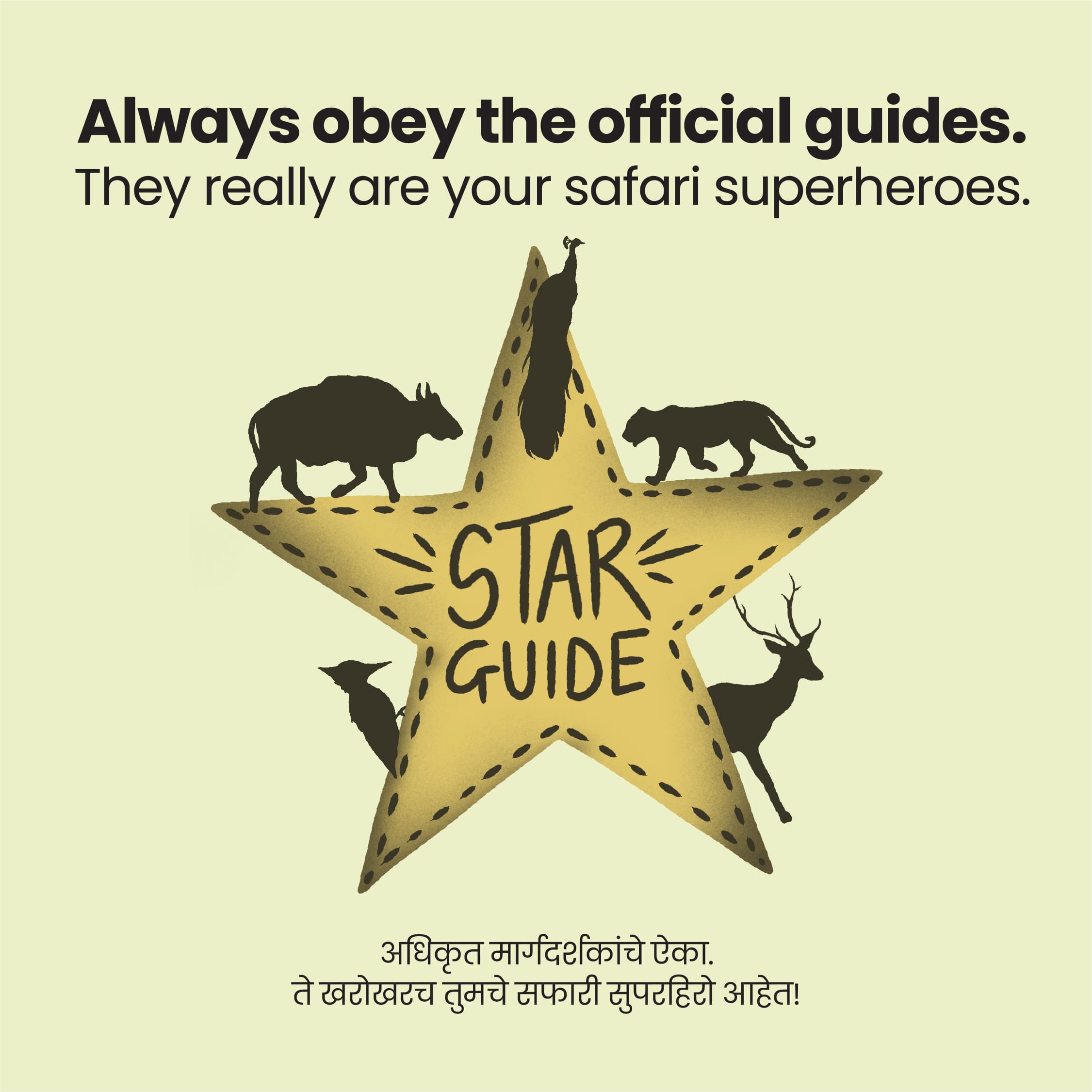The best safari is an ethical one!
Violation of any mentioned rules will invite legal action and fine.




















Long before Tadoba became a haven for tigers and wildlife lovers, it was a land of kings, warriors, and ancient forests. The Gond rulers reigned here for centuries, their stories woven into the very roots of these trees. Then came the Marathas, followed by the British.Ask the villagers, the old storytellers of this land, and they will tell you about Taru, who became a legend. Taru was no ordinary man—he was a brave Gond headman, respected and strong. One fateful day, near a shimmering lake, he came face-to-face with a mighty tiger. What happened next is a tale passed down through generations. Some say Taru fought bravely and defeated the tiger. Others believe he gave his life in battle, his courage unmatched. Whichever version you believe, Taru’s spirit became part of the land. A shrine was built in his honour, and the forests and lake around it came to bear his name. Taru became Tadoba!
In 1879, it was declared a Reserved Forest—not to protect its tigers or birds, but its timber. By 1905, tiger hunting was restricted, though special permits still allowed the wealthy to claim their trophies. In 1931, shooting of all animals was controlled, and by 1935, a 45 sq km sanctuary was created around Tadoba Lake. Even then, parts of the forest were still open for hunting, permits were handed out, and shots rang through the trees in places like Karwa and Kalsa. Finally, in 1955, Tadoba was officially declared a national park, one of India’s first. But the battle wasn’t over. Cultivation, poaching, and exploitation continued, threatening the wildlife this land was meant to protect. In 1970s, hunting blocks were finally shut down. Then, in 1986, a vast stretch of 506 sq km was declared the Andhari Wildlife Sanctuary, and in 1993, Tadoba and Andhari were merged to create what we now know as the Tadoba-Andhari Tiger Reserve (TATR), spanning 622.87 sq km. Today, as tigers prowl freely here and the forests breathe again, Taru’s legacy lives on, not just in legend but in every roar that echoes through his land.


Long before Tadoba became a haven for tigers and wildlife lovers, it was a land of kings, warriors, and ancient forests. The Gond rulers reigned here for centuries, their stories woven into the very roots of these trees. Then came the Marathas, followed by the British.Ask the villagers, the old storytellers of this land, and they will tell you about Taru, who became a legend. Taru was no ordinary man—he was a brave Gond headman, respected and strong. One fateful day, near a shimmering lake, he came face-to-face with a mighty tiger. What happened next is a tale passed down through generations. Some say Taru fought bravely and defeated the tiger. Others believe he gave his life in battle, his courage unmatched. Whichever version you believe, Taru’s spirit became part of the land. A shrine was built in his honour, and the forests and lake around it came to bear his name. Taru became Tadoba!
In 1879, it was declared a Reserved Forest—not to protect its tigers or birds, but its timber. By 1905, tiger hunting was restricted, though special permits still allowed the wealthy to claim their trophies. In 1931, shooting of all animals was controlled, and by 1935, a 45 sq km sanctuary was created around Tadoba Lake. Even then, parts of the forest were still open for hunting, permits were handed out, and shots rang through the trees in places like Karwa and Kalsa. Finally, in 1955, Tadoba was officially declared a national park, one of India’s first. But the battle wasn’t over. Cultivation, poaching, and exploitation continued, threatening the wildlife this land was meant to protect. In 1970s, hunting blocks were finally shut down. Then, in 1986, a vast stretch of 506 sq km was declared the Andhari Wildlife Sanctuary, and in 1993, Tadoba and Andhari were merged to create what we now know as the Tadoba-Andhari Tiger Reserve (TATR), spanning 622.87 sq km. Today, as tigers prowl freely here and the forests breathe again, Taru’s legacy lives on, not just in legend but in every roar that echoes through his land.

The notification of the tiger reserve was, of course, only a beginning. The TATR that you see today, this internationally acclaimed biodiversity haven, is the legacy of all the dedicated forest officers, frontline forest staff, and members of NGOs and fringe communities that have worked over the decades to protect it. Sustained conservation efforts have led to the revival of tigers and other wildlife here. These have included the creation of undisturbed areas through the incentivised voluntary relocation of villages from inside the core area, grassland development to improve prey base populations, improving of water availability through water conservation measures, intensive monitoring of tigers, and most important, strong, sustained protection measures to safeguard wildlife from all threats.
Today, Tadoba-Andhari Tiger Reserve is regarded as one of the world’s most preferred tiger destinations, a glittering jewel in the Project Tiger crown. We are proud that our tigers (over 80 in the reserve and 200 in the larger landscape) are secure and able to multiply in the presence of humans. Thanks to the reserve’s functional connectivity with other protected areas in the central Indian tiger landscape, Tadoba’s tigers are now found restocking the gene pools of protected areas such as Navegaon-Nagzira, Umred-Karhandla and Tipeshwar, and forests as far afield as Kawal, Nagarjunsagar and Indravati.
Tigers generate the most interest and occupy the top position in the food web but it is the forest in its entirety, all creatures great and small, that make this tiger reserve tick. Tadoba’s enchantment is in the southern tropical dry deciduous jungle with its myriad grasslands and waterbodies. It is in the groves of bamboo, a keystone plant in this landscape that supplements food availability for herbivores, keeps invasive weeds at bay, and serves as both safe harbour and ambush cover for different species. It is in the stunning variety of insect life and bird life: the azure dartlets and the harvestmen, the lesser adjutant storks and the oriental magpie-robins, the Tickell’s blue flycatchers and the Indian silverbills. It is in the prey species, the wild pigs and sambar and chital, and in the predators, the jungle cats and wild dogs, the leopards and the mugger crocodiles, and the mighty tigers.
On behalf of my team, I welcome you to enjoy the variety that Tadoba-Andhari Tiger Reserve offers. Immerse yourself in this magical landscape, allow yourself to be enchanted by it. And remember that people have laid down their lives to protect it. Respect it, for it is your natural heritage.
Field Director,
Tadoba-Andhari Tiger Reserve,
Chandrapur, Maharashtra
The notification of the tiger reserve was, of course, only a beginning. The TATR that you see today, this internationally acclaimed biodiversity haven, is the legacy of all the dedicated forest officers, frontline forest staff, and members of NGOs and fringe communities that have worked over the decades to protect it. Sustained conservation efforts have led to the revival of tigers and other wildlife here. These have included the creation of undisturbed areas through the incentivised voluntary relocation of villages from inside the core area, grassland development to improve prey base populations, improving of water availability through water conservation measures, intensive monitoring of tigers, and most important, strong, sustained protection measures to safeguard wildlife from all threats.
Today, Tadoba-Andhari Tiger Reserve is regarded as one of the world’s most preferred tiger destinations, a glittering jewel in the Project Tiger crown. We are proud that our tigers (over 80 in the reserve and 200 in the larger landscape) are secure and able to multiply in the presence of humans. Thanks to the reserve’s functional connectivity with other protected areas in the central Indian tiger landscape, Tadoba’s tigers are now found restocking the gene pools of protected areas such as Navegaon-Nagzira, Umred-Karhandla and Tipeshwar, and forests as far afield as Kawal, Nagarjunsagar and Indravati.
Tigers generate the most interest and occupy the top position in the food web but it is the forest in its entirety, all creatures great and small, that make this tiger reserve tick. Tadoba’s enchantment is in the southern tropical dry deciduous jungle with its myriad grasslands and waterbodies. It is in the groves of bamboo, a keystone plant in this landscape that supplements food availability for herbivores, keeps invasive weeds at bay, and serves as both safe harbour and ambush cover for different species. It is in the stunning variety of insect life and bird life: the azure dartlets and the harvestmen, the lesser adjutant storks and the oriental magpie-robins, the Tickell’s blue flycatchers and the Indian silverbills. It is in the prey species, the wild pigs and sambar and chital, and in the predators, the jungle cats and wild dogs, the leopards and the mugger crocodiles, and the mighty tigers.
On behalf of my team, I welcome you to enjoy the variety that Tadoba-Andhari Tiger Reserve offers. Immerse yourself in this magical landscape, allow yourself to be enchanted by it. And remember that people have laid down their lives to protect it. Respect it, for it is your natural heritage.
Field Director,
Tadoba-Andhari Tiger Reserve,
Chandrapur, Maharashtra
